Strawberry Cheesecake
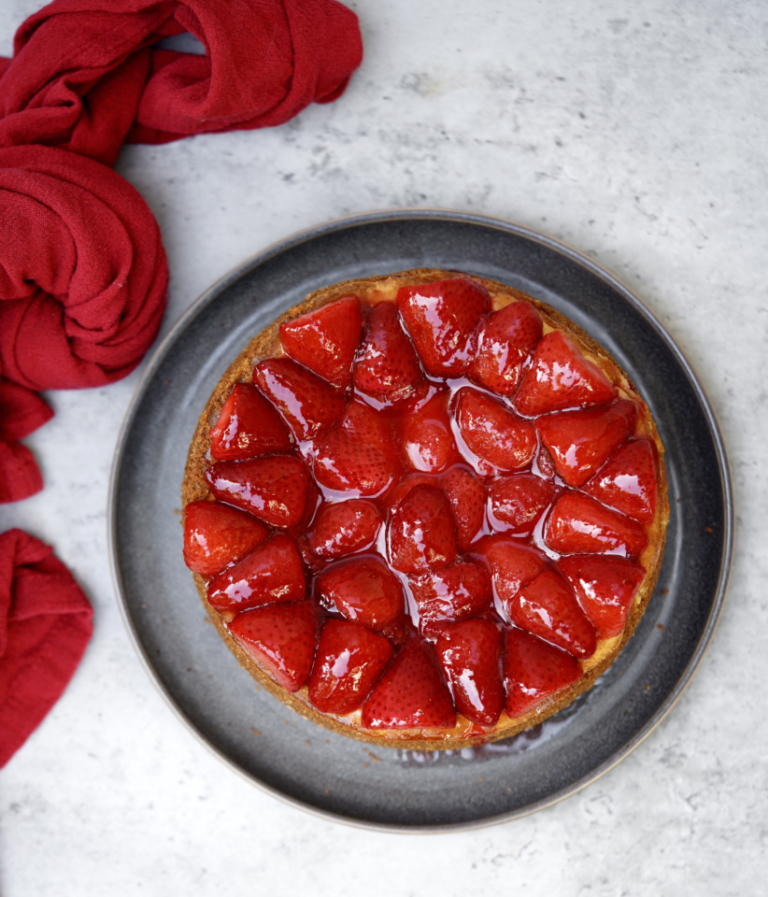
Strawberry cheesecake is the ultimate indulgence and something I find cathartic to make. Cheesecake travels the globe and can be traced back 4,000 years to the fifth century BC, to ancient Greece and the island of Samos. At this time, the cheesecake was made with patties of fresh cheese, flour, and honey. These cakes were pounded smooth and baked on an earthenware griddle. Later, during the late medieval ages, cheesecake was transformed to include a pastry base and resembled a more traditional tart. This version of cheesecake had multiple variations, but unlike its earlier version, now included eggs and different flavoring agents.
This iconic dessert quickly made its way to the American colonies and was officially referenced in Martha Washington’s prized cookbook, which was a collection of handwritten recipes Martha was given by her mother-in-law at her wedding. Three different cheesecake recipes were included in this historical cookbook. One of these recipes was very similar to the crustless Ancient Greek version mentioned above. These early cheesecakes were flavored with rosewater and other simple spices. It was not until the 19th century that cheesecake began to feature more modern-day flavors, such as lemon and vanilla.
American Cheesecake
Styles of Cheesecake
- Italian Cheesecake: farmer, pot, cottage cheese or ricotta
- German Cheesecake: quark
- New York Cheesecake: cream cheese
New York-Style Cheesecake
This strawberry cheesecake is a New York-style cheesecake made with full-fat cream cheese. The soft, unaged, cream cheese gives this cheesecake a mild flavor with a subtle tang. Some still question it, but Arnold Reuben, a German-Jewish immigrant restauranteur from Manhattan, takes credit for inventing New York-style cheesecake. But Reuben also claims credit for the invention of the famous Reuben sandwich, (consisting of a grilled corned beef on rye with Russian dressing, sauerkraut, and Swiss cheese), which is also debatable.
But as far as cheesecake is concerned, Reuben claimed he was served a sweet “cheese pie” at a 1929 dinner party, and enjoyed it so much he got the recipe from the hostess. Ruben tinkered with the ingredients, substituting cream cheese for curds. Reuben’s served his new-style cheesecake to patrons at his restaurants generating extensive praise and spinning off numerous imitations by fellow rivals, further increasing the dessert’s popularity.
If Reuben introduced cream cheese cheesecake to New York, many food historians will argue it was not Reuben, but Lindy’s Restaurant that actually put it in the limelight. In August 1921, Leo “Lindy” Lindemann and his wife Clara, (from Manhattan, by way of Berlin, Germany), opened a deli on Broadway in Midtown Manhattan, in the heart of the Theater District. Lindy’s featured a creamy cheesecake topped with strawberries in a “gel“. Legend has it, that Lindy hired Reuben’s baker to procure the top-secret cheesecake recipe from Ruben and then claimed it as his own.
Although the two cakes were not identical, they were very similar. Clementine Paddleford, who is known as America’s first food journalist, published a story including what was believed to be Lindy’s cheesecake recipe, in a 1948 Los Angeles Times article titled, “Here’s the Recipe for a Broadway Favorite, held Secret Till Now”. This recipe, which had cream cheese, heavy cream, and a “cookie dough” crust, sky-rocked the dessert even further, and the rest they say is cheesecake history.
New York-style cheesecake has always been my favorite, perhaps that’s because I grew up in NYC. As a kid, I preferred it straight up, sans any fruit or god-for-bid, any gelatinous gel topping. But I’ve matured since then. The older me still prefers New York-style cheesecake over the others, but I now love strawberries on top, which I feel, flavor and texture-wise, compliments the creamy cheesecake perfectly. But to be perfectly clear, I’m still not a “gel” fan, that is just something I can never get behind.
Strawberry Cheesecake
Ingredients:
For the Graham Cracker Crust:
- Half of a (14.4 ounce box) honey graham crackers
- 1/2 cup unsalted butter, melted
For the Filling:
- Two (8-ounce) packages of full-fat cream cheese, softened
- 2 tablespoons all-purpose flour
- 1 teaspoon vanilla extract
- 1/2 cup full-fat sour cream
- 1 1/2 cups caster sugar
- 3 eggs, room temperature
For the Strawberry Topping:
- 1 pound strawberries, hulled, half diced, and half cut in half
- 1/2 cup sugar
- 1/2 teaspoon vanilla extract
- 1 1/2 teaspoons cornstarch
- 1 tablespoon water
Directions:
- Preheat the oven to 325 degrees F. Using an 8-inch springform cake pan, remove the bottom and place a large piece of parchment paper over the base. Place the ring over the parchment-covered bottom and secure it in place. The sides of the parchment should be outside the pan, leaving only the bottom of the pan covered with parchment. Lightly grease the parchment and sides of the cake pan and set on a baking sheet.
- For the Graham cracker crust: Using your hands break up the graham crackers and place them in a food processor, such as a Cuisinart, fitted with a blade attachment. Pule on/off until you have fine crumbs. Add the melted butter, and pulse again until it resembles wet sand.
- Pour the graham cracker mixture into the prepared cake pan. Use your hands to spread it over the base and the walls. Note: do not worry about completely covering the walls of the pan, just spread the crumbs up as high as you can keeping the thickness as even as possible. Set the pan near your workstation.
- For the Filling: In a kitchen mixer, such as a KitchenAid, fitted with a whisk attachment, add the cream cheese and beat until just smooth. Do not overbeat, this can cause cracking when baking. Add the vanilla, sour cream, and sugar and beat until just combined.
- Add the eggs one at a time, beating in between until just combined. Pour the filling into the prepared pan and use a rubber-tip spatula to smooth the top. Place the cheesecake in the oven and bake for about 50-55 minutes, or until the top is a light golden brown, and it jiggles slightly when you gently shake the pan. Remove from the oven and cool the cheesecake on the counter completely. Once cool, cover with plastic wrap and refrigerate for at least 4 hours.
- For the Strawberry Topping: In a small saucepan add the chopped strawberries, vanilla, and sugar, place over medium heat, and bring to a simmer. Once simmering, reduce the heat and cook for about 10 minutes, or until strawberries break down. Next, add the cornstarch with water. Add the halved strawberries to the mixture and cook for 1-2 minutes to soften slightly. Remove the sauce from the stove and cool completely.
- To Assemble the Cheesecake: Remove the cheesecake from the refrigerator, and remove the side of the cake pan. Use the overhang parchment paper to slide the cheesecake off the cake pan. Then slide the cheesecake off the paper and place it on a serving platter. Spoon the strawberry sauce onto the cheesecake, covering the top with a single layer of strawberries. Use your hands to slip the strawberry halves so they are facedown. Place the cheesecake back in the refrigerator for at least 2 hours before serving.

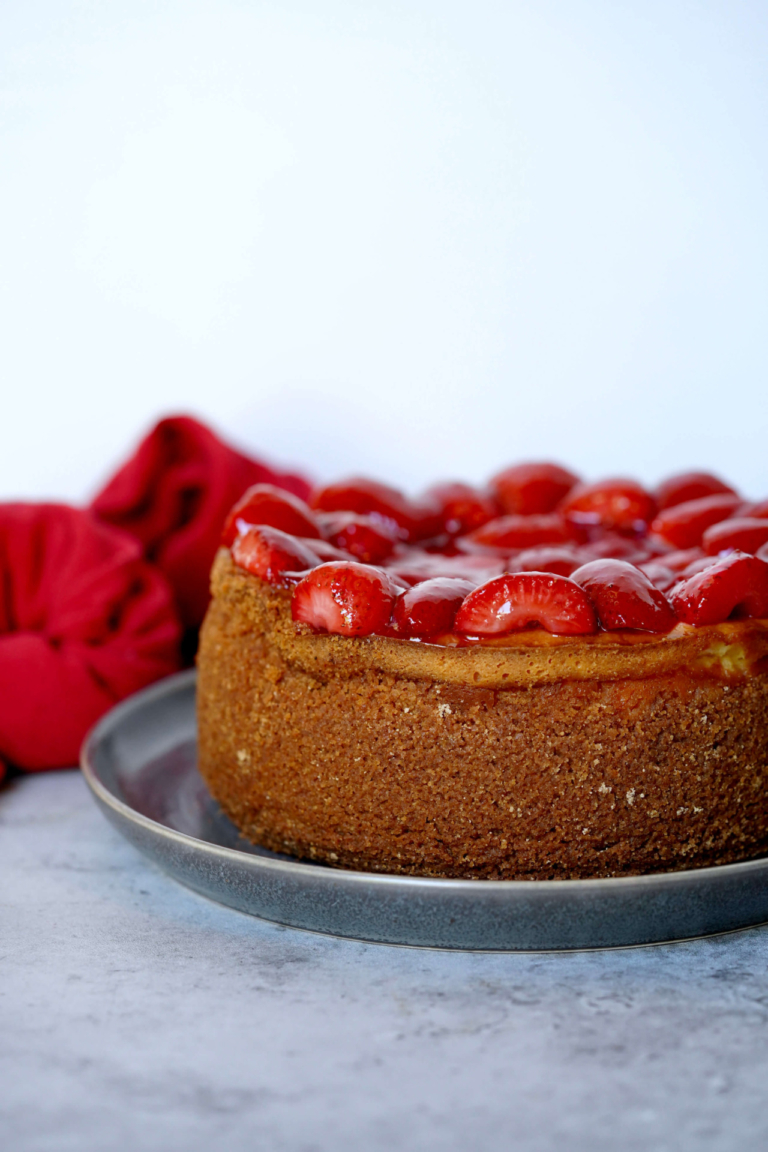
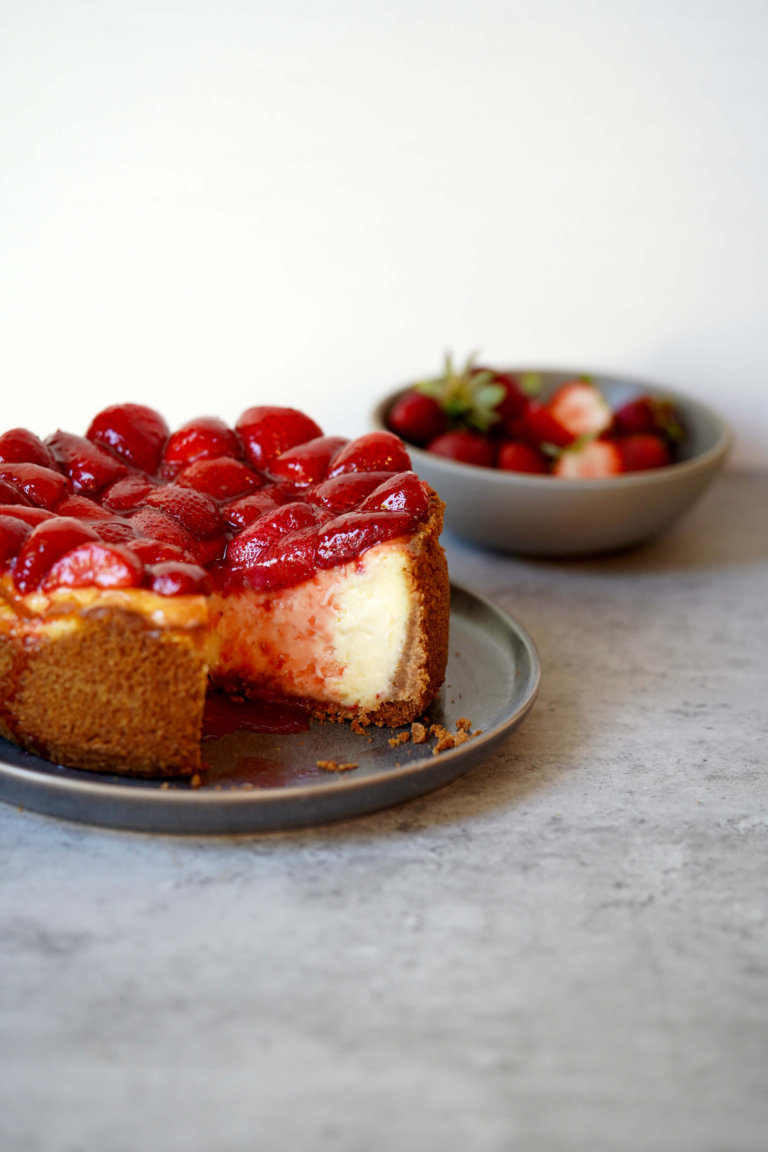
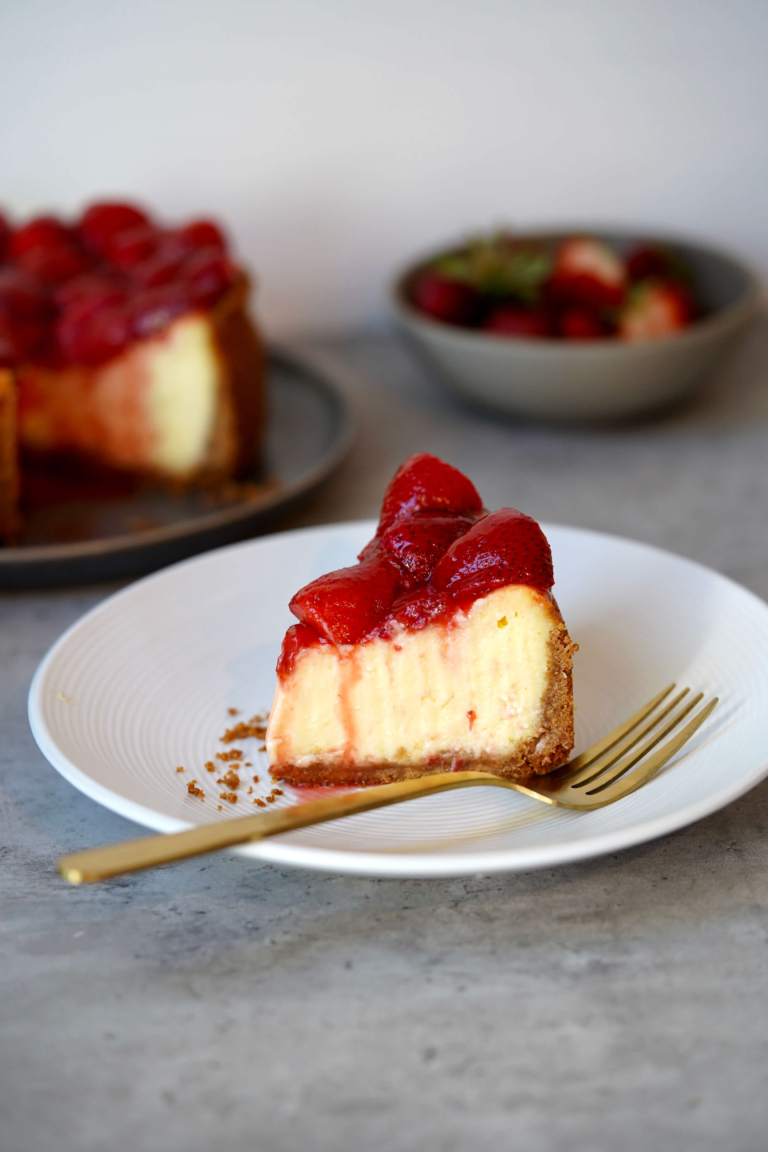
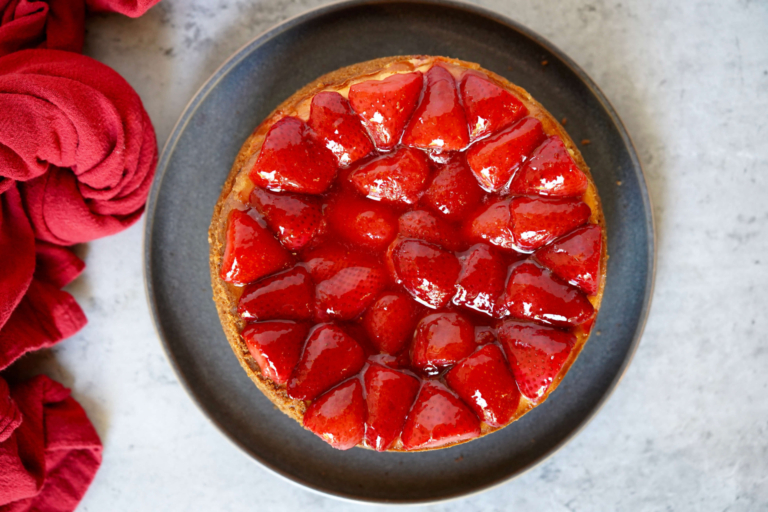
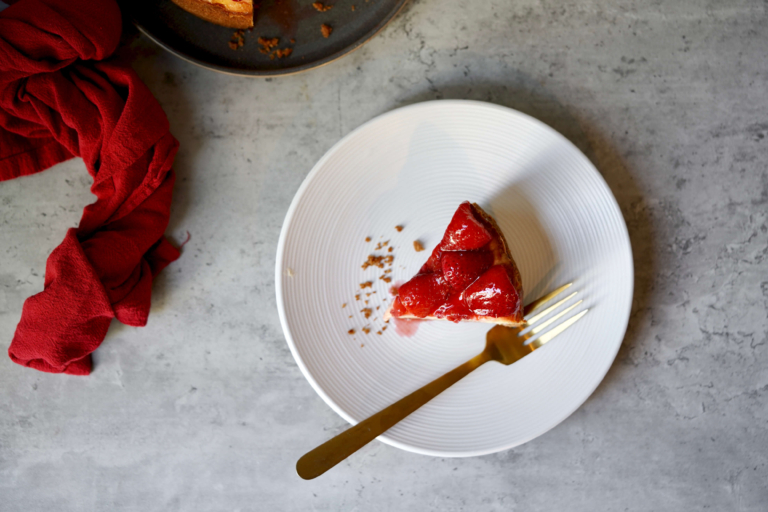


Hi Andrea,
How do you get your strawberries to stay such a beautiful red color? Mine look kinda dull after simmering them.
Hi Holly- Thanks so much for reaching out. To keep the strawberries vibrant, it’s important to use ripe, fresh berries and to only briefly cook the berries used for the top. If you cook too long, the color will be dull. I hope this helps and you enjoy the cheesecake.